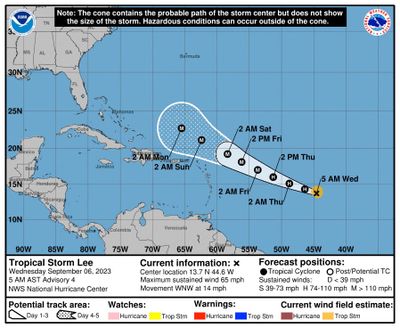Hurricane Lee forms, and it’s forecast to explode into Category 4 by Saturday

FORT LAUDERDALE, Fla. – Lee intensified into a hurricane Wednesday evening with maximum sustained wind speeds of 75 mph, and the storm is expected to quickly strengthen into an “extremely dangerous” major hurricane with potential top wind speeds of 150 mph, putting it at the higher end of the Category 4 range, the National Hurricane Center said.
“No direct impacts to South Florida are expected at this time,” the National Weather Service in Miami said Tuesday night on X, the social media platform formerly known as Twitter. Officials have warned Floridians, amid peak hurricane season, to ensure their storm supplies are ready.
As of 5 p.m. Eastern time Wednesday, Lee was 1,130 miles east of the northern Leeward Islands, the eastern boundary of the Caribbean. Lee was moving west-northwest at 14 mph with maximum sustained winds of 75 mph. Tropical-storm-force winds reached up to 90 miles from Lee’s center, and hurricane-force winds reached up to 15 miles out.
Wind shear “could keep Lee in check for the next day or two,” but that is expected to decrease by Friday, allowing Lee to rapidly intensify as it moves over abnormally warm water. Forecasters say Lee will be a major hurricane by early Saturday.
“There is increasing confidence on Lee becoming a very powerful hurricane by this weekend,” the hurricane center said.
Its forecast track shows the hurricane headed in the general direction of the Bahamas and potentially Florida. But it is too early to know exactly how close the system will get to the islands of the eastern Caribbean, though they could feel impacts by the weekend, the National Hurricane Center’s latest update said. The current cone indicating the probable path of the eye of the storm sits just north of Puerto Rico, Haiti and the Dominican Republic.
Swells from the storm should reach some of the easternmost islands of the Caribbean on Friday, and the British and U.S. Virgin Islands and Puerto Rico this weekend. These swells could cause life-threatening surf and rip current conditions, the National Hurricane Center said.
As of the hurricane center’s Wednesday afternoon estimate, there’s a low chance that tropical-storm-force winds could reach Puerto Rico and some northern and eastern areas of the Dominican Republic this weekend as Lee’s core is currently expected to stay north of the islands.
“The high pressure to the north of it, that’s what’s going to steer it,” said Anthony Reynes, senior forecaster with the National Weather Service in Miami.
“Tropical systems, they cannot go against the flow of the high pressure, they have to go around it … once it moves to the north of Puerto Rico, it’s going to start shifting more to the north and eventually northeast. The cyclone is moving around the edge of that high.”
There also will be a low pressure trough moving east over the U.S. that should also contribute to the northward motion of the storm, he said.
The system will be traveling over record-warm water, close to 86 degrees.
Lee is the fourth Atlantic hurricane of the 2023 season, behind Don, Franklin and Idalia, and will be the third major hurricane, meaning Category 3 or above. Franklin and Idalia were major hurricanes.
Another tropical depression is likely to form later in the week from a tropical wave off the coast of Africa and move west-northwest toward the eastern and central tropical Atlantic. Its disorganized showers and thunderstorms were beginning to spread over the islands off of Africa on Wednesday night, the hurricane center’s latest update said.
As of 8 p.m. Wednesday, its odds of developing were at 70% within seven days, and 40% within two days, increased odds from earlier in the day. It will move over the Cabo Verde Islands off Africa overnight and Thursday, the hurricane center said.
Meanwhile, the remnants of Hurricane Franklin were given a 30% chance of gaining “some subtropical or tropical characteristics” in the next seven days over the warm waters to the west-northwest of the northwestern coast of Spain. It is not expected to further develop, though, by Thursday night.
The National Hurricane Center, which operates under the National Oceanic Atmospheric Administration, has forecast 14 to 21 named storms, including six to 11 hurricanes, and two to five major hurricanes.
The National Hurricane Center has been predicting an “above-normal” 2023 hurricane season as a result of ongoing record-breaking sea surface temperatures that continue to fight off the tempering effects of El Niño.
While sea-surface temperatures have remained hot for longer than anticipated, El Niño’s effects, which typically reduce hurricane chances, have emerged more slowly.